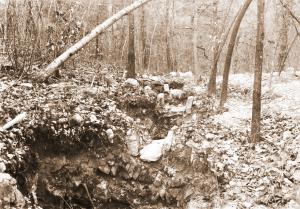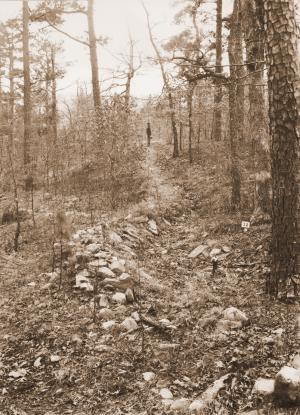| Collection: | Southern Research Station Historical Documents and Images |
| Keywords: |
water diverter storm flow peak flow |
| Location: | Irons Fork Experimental Forest, Arkansas |
| Description: | Diversion spreader #2, one of the water diversion spreader systems as a part of a forest engineering project on the Irons Fork Experimental Forest. These structures, constructed in 1939 in the Rock Creek drainage of Irons Fork, were designed to help capture/slow stormflow along the ridges to help reduce peak flow in stream channels in the valleys. Photographs were taken before 1943 by an unknown USFS photographer and used in an unpublished report by Assistant Forester John L. Arend. |
| Date: | 1942? |
| Collection: | Southern Research Station Historical Documents and Images |
| Keywords: |
water diverter storm flow peak flow |
| Location: | Irons Fork Experimental Forest, Arkansas |
| Description: | Diversion spreader #3, one of the water diversion spreader systems as a part of a forest engineering project on the Irons Fork Experimental Forest. These structures, constructed in 1939 in the Rock Creek drainage of Irons Fork, were designed to help capture/slow stormflow along the ridges to help reduce peak flow in stream channels in the valleys. Photographs were taken before 1943 by an unknown USFS photographer and used in an unpublished report by Assistant Forester John L. Arend. |
| Date: | 1942? |
| Collection: | Southern Research Station Historical Documents and Images |
| Keywords: |
water diverter storm flow peak flow |
| Location: | Irons Fork Experimental Forest, Arkansas |
| Description: | Masonry baffle on diversion spreader #4, one of the water diversion spreader systems as a part of a forest engineering project on the Irons Fork Experimental Forest. These structures, constructed in 1939 in the Rock Creek drainage of Irons Fork, were designed to help capture/slow stormflow along the ridges to help reduce peak flow in stream channels in the valleys. Photographs were taken before 1943 by an unknown USFS photographer and used in an unpublished report by Assistant Forester John L. Arend. |
| Date: | 1942? |
| Collection: | Southern Research Station Historical Documents and Images |
| Keywords: |
water diverter storm flow peak flow |
| Location: | Irons Fork Experimental Forest, Arkansas |
| Description: | Ditch leading to spreader system for diversion spreader #4, one of the water diversion spreader systems as a part of a forest engineering project on the Irons Fork Experimental Forest. These structures, constructed in 1939 in the Rock Creek drainage of Irons Fork, were designed to help capture/slow stormflow along the ridges to help reduce peak flow in stream channels in the valleys. Photographs were taken before 1943 by an unknown USFS photographer and used in an unpublished report by Assistant Forester John L. Arend. |
| Date: | 1942? |
| Collection: | Southern Research Station Historical Documents and Images |
| Keywords: |
water diverter storm flow peak flow |
| Location: | Irons Fork Experimental Forest, Arkansas |
| Description: | Circular storage pits on diversion spreader #5, one of the water diversion spreader systems as a part of a forest engineering project on the Irons Fork Experimental Forest. These structures, constructed in 1939 in the Rock Creek drainage of Irons Fork, were designed to help capture/slow stormflow along the ridges to help reduce peak flow in stream channels in the valleys. Photographs were taken before 1943 by an unknown USFS photographer and used in an unpublished report by Assistant Forester John L. Arend. |
| Date: | 1942? |
| Collection: | Southern Research Station Historical Documents and Images |
| Keywords: |
water diverter storm flow peak flow |
| Location: | Irons Fork Experimental Forest, Arkansas |
| Description: | Diversion spreader #7, one of the water diversion spreader systems as a part of a forest engineering project on the Irons Fork Experimental Forest. These structures, constructed in 1939 in the Rock Creek drainage of Irons Fork, were designed to help capture/slow stormflow along the ridges to help reduce peak flow in stream channels in the valleys. Photographs were taken before 1943 by an unknown USFS photographer and used in an unpublished report by Assistant Forester John L. Arend. |
| Date: | 1942? |
| Collection: | Southern Research Station Historical Documents and Images |
| Keywords: |
water diverter storm flow peak flow |
| Location: | Irons Fork Experimental Forest, Arkansas |
| Description: | Diversion spreader #9, one of the water diversion spreader systems as a part of a forest engineering project on the Irons Fork Experimental Forest. These structures, constructed in 1939 in the Rock Creek drainage of Irons Fork, were designed to help capture/slow stormflow along the ridges to help reduce peak flow in stream channels in the valleys. Photographs were taken before 1943 by an unknown USFS photographer and used in an unpublished report by Assistant Forester John L. Arend. |
| Date: | 1942? |
| Collection: | Southern Research Station Historical Documents and Images |
| Keywords: |
water diverter storm flow peak flow |
| Location: | Irons Fork Experimental Forest, Arkansas |
| Description: | Earthen baffle rip-rapped with rock on diversion spreader #10, one of the water diversion spreader systems as a part of a forest engineering project on the Irons Fork Experimental Forest. These structures, constructed in 1939 in the Rock Creek drainage of Irons Fork, were designed to help capture/slow stormflow along the ridges to help reduce peak flow in stream channels in the valleys. Photographs were taken before 1943 by an unknown USFS photographer and used in an unpublished report by Assistant Forester John L. Arend. |
| Date: | 1942? |
| Collection: | Southern Research Station Historical Documents and Images |
| Keywords: |
water diverter storm flow peak flow |
| Location: | Irons Fork Experimental Forest, Arkansas |
| Description: | Diversion spreader #11, one of the water diversion spreader systems as a part of a forest engineering project on the Irons Fork Experimental Forest. These structures, constructed in 1939 in the Rock Creek drainage of Irons Fork, were designed to help capture/slow stormflow along the ridges to help reduce peak flow in stream channels in the valleys. Photographs were taken before 1943 by an unknown USFS photographer and used in an unpublished report by Assistant Forester John L. Arend. |
| Date: | 1942? |
| Collection: | Southern Research Station Historical Documents and Images |
| Keywords: |
water diverter storm flow peak flow |
| Location: | Irons Fork Experimental Forest, Arkansas |
| Description: | Diversion spreader #12, one of the water diversion spreader systems as a part of a forest engineering project on the Irons Fork Experimental Forest. These structures, constructed in 1939 in the Rock Creek drainage of Irons Fork, were designed to help capture/slow stormflow along the ridges to help reduce peak flow in stream channels in the valleys. Photographs were taken before 1943 by an unknown USFS photographer and used in an unpublished report by Assistant Forester John L. Arend. |
| Date: | 1942? |










